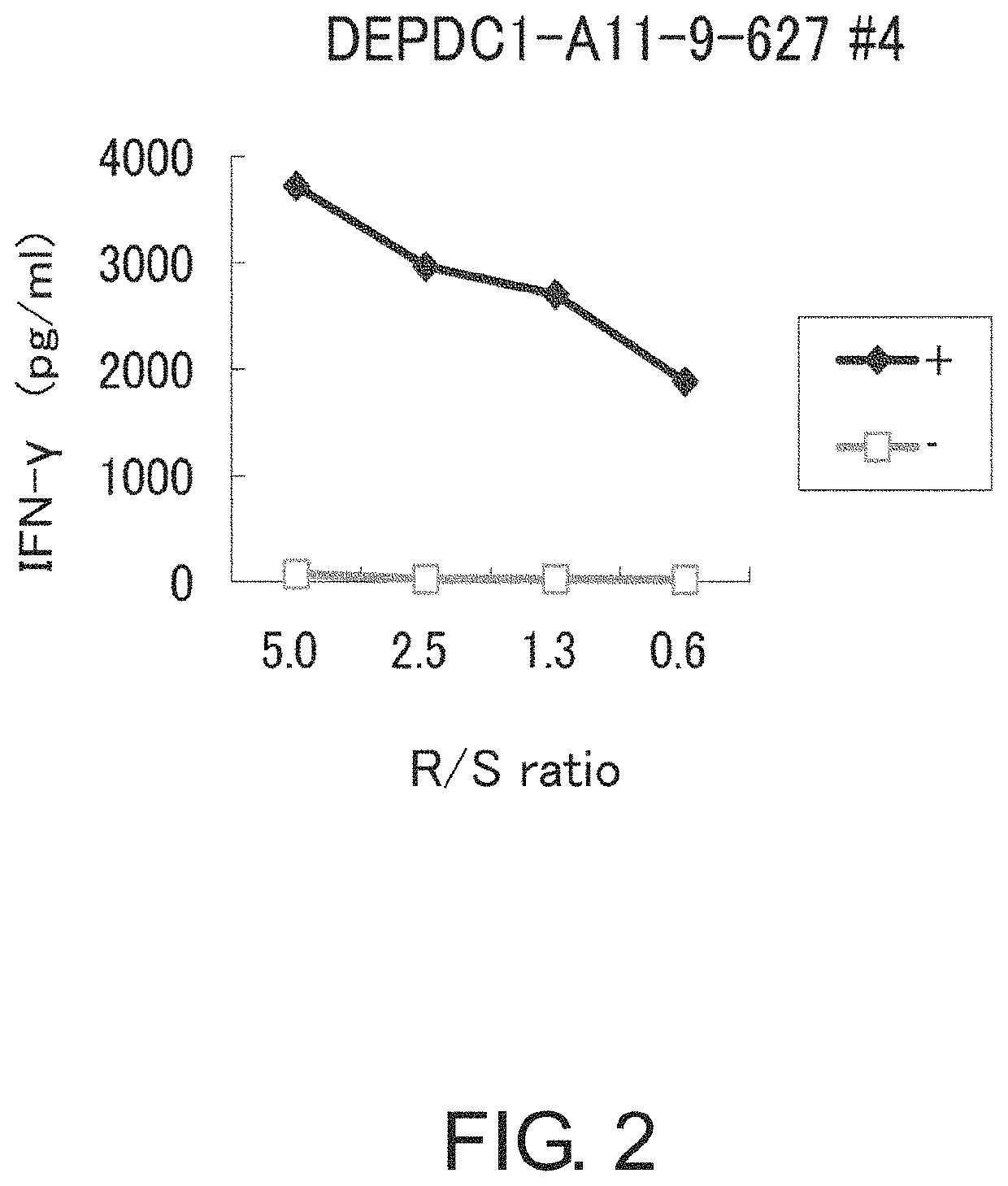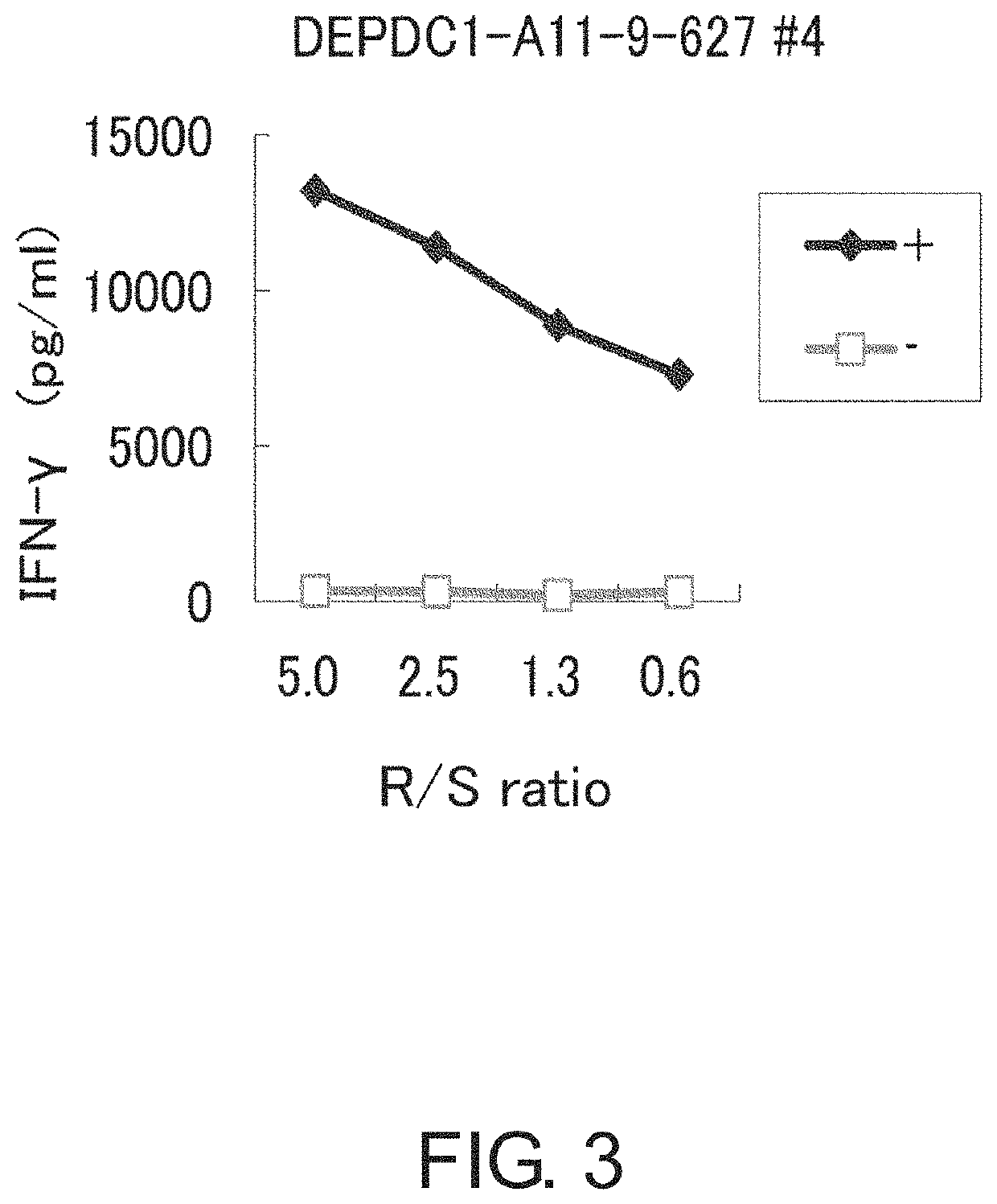DEPDC1-derived peptide and vaccine containing same
a peptide and vaccine technology, applied in the field of biological science, can solve the problems that conventional peptides are not suitable for immunotherapy in subjects, and achieve the effect of specific and potent immune respons
- Summary
- Abstract
- Description
- Claims
- Application Information
AI Technical Summary
Benefits of technology
Problems solved by technology
Method used
Image
Examples
example 1
Materials and Methods
Cell Lines
[0454]C1R, an HLA-A- and HLA-B-negative human B lymphoblastoid cell line, and COST, an African green monkey kidney cell line, were purchased from ATCC.
Generation of Stimulator Cells with Stable HLA-A*1101 Expression
[0455]C1R (C1R-A11) that stably expresses HLA-A*1101 was used as a stimulator cell. A cDNA encoding the open-reading frame of HLA-A*1101 was amplified by PCR and cloned into an expression vector. C1R cells were transfected with the expression vector, and then selected using G418 (Invitrogen) for two weeks. The G418-selected cells were seeded into wells containing G418-added culture medium in a 96-well plate, and further cultured for 30 days. The exogenous HLA-A*1101 expression in C1R cells was verified by flow cytometric analysis.
Selection of Candidate DEPDC1-Derived Peptides
[0456]DEPDC1-derived 9 mer and 10 mer peptides that hind to the HLA-A*1101 molecule were predicted using the binding prediction software “NetMHC 12” (Beaus et al., Tissu...
example 2
Materials and Methods
Cell Lines
[0471]C1R, an HLA-A- and HLA-B-negative human B lymphoblastoid cell line, and COST, an African green monkey kidney cell line, were purchased from ATCC.
Generation of Stimulator Cells with Stable HLA-A*0101 Expression
[0472]C1R (C1R-A01) that stably expresses HLA-A*0101 was used as a stimulator cell. A cDNA encoding the open-reading frame of HLA-A*0101 was amplified by PCR and cloned into an expression vector. C1R cells were transfected with the expression vector, and then selected using G418 (Invitrogen) for two weeks. The G418-selected cells were seeded into wells containing G418-added culture medium in a 96-well plate, and further cultured for 30 days. The exogenous HLA-A*0101 expression in C1R cells was verified by flow cytometric analysis.
Selection of Candidate DEPDC1-Derived Peptides
[0473]DEPDC1-derived 9mer, 10mer, and 11mer peptides that bind to the HLA-A*0101 molecule were predicted using the binding prediction software “NetMHC 3.2” (www.cbs.dtu....
example 3
Preparation of Emulsion Formulations
[0489]A peptide was dissolved in an injection solvent or sterile physiological saline to become 1.0 mg / ml to 10.0 mg / ml, and collected into a syringe. This was connected via a connector to a syringe filled with an IFA in an amount equivalent to an injection solvent or sterile physiological saline, and mixed by alternately pushing the syringe plungers of the two connected syringes. After several minutes of mixing, completion of the emulsion was assessed by the drop test method. The drop test method can be performed by dropping one drop of the mixed sample on water. The emulsion is assessed as completed when the sample dropped on water does not immediately diffuse in water; and the emulsion is assessed as incompleted when the sample dropped on water diffuses right away in water. When the emulsion is assessed as incompleted, further mixing is carried out to complete the emulsion. The completed emulsion can be administered to a cancer patient by subcu...
PUM
| Property | Measurement | Unit |
|---|---|---|
| sizes | aaaaa | aaaaa |
| chemical | aaaaa | aaaaa |
| dry weight basis | aaaaa | aaaaa |
Abstract
Description
Claims
Application Information
 Login to View More
Login to View More - R&D
- Intellectual Property
- Life Sciences
- Materials
- Tech Scout
- Unparalleled Data Quality
- Higher Quality Content
- 60% Fewer Hallucinations
Browse by: Latest US Patents, China's latest patents, Technical Efficacy Thesaurus, Application Domain, Technology Topic, Popular Technical Reports.
© 2025 PatSnap. All rights reserved.Legal|Privacy policy|Modern Slavery Act Transparency Statement|Sitemap|About US| Contact US: help@patsnap.com



